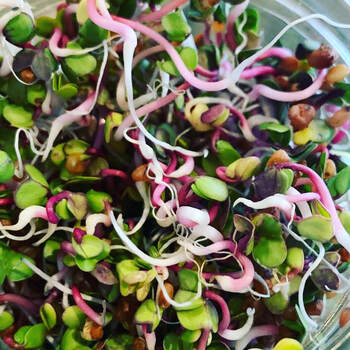|
By: Will Roth Like many others, the tumultuous nature of this past year compelled me to plant a garden. I refrained from calling it a “Victory Garden,” skeptical of jinxing things on my first real attempt at growing food. Sure enough, that decision proved prescient, as the radishes that I harvested (weeks after they should have been ready) were about the width of a Ticonderoga #2 pencil. They tasted as if they were full of rage. I ate them all anyway. Luckily, there are more foolproof methods of growing food. Sprouts and microgreens are fast-growing, packed full of beneficial vitamins and compounds, and the only investment they require is the seeds themselves. It’s this rare win-win-win scenario that compelled Alison Godlewski of Teton Valley, Idaho, to offer free Zoom classes to help others get started. “I really want to share this information because it’s so exciting and fun and fascinating, so I decided to make it a personal goal of mine to get 200 people to try growing sprouts or microgreens that have never done it before,” she said. This is good news for those of you who, like me, need some help rescuing their “Victory Garden” from the jaws of defeat.
Ms. Godlewski first started growing sprouts and microgreens 15 years ago when a friend gifted her a kit. She then dove deeper into the hobby after researching how food can be used as medicine to combat health issues. Sprouts can have up to 50 times more nutritional benefits than mature plants. “Sprouting lentils increases their Vitamin C by 400%,” Ms. Godlewski said. Cruciferous plants, like broccoli, cabbage, and kale, contain a compound called Sulforaphane, which “can protect cells from the sort of damage that can instigate cancer,” according to a Johns Hopkins study. There is more Sulforaphane in the sprouts of these plants than there is once they’re mature. “[Sprouts and microgreens are] more nutrient dense, so you don’t even have to eat as much to get the same nutrients, or you can eat as much and get more nutrients,” Ms. Godlewski said. Growing sprouts and microgreens can dramatically shrink your carbon footprint. Where we live in Eastern Idaho, fresh produce has to be trucked (or even flown) to the supermarket from as far away as Mexico. “Think about the carbon footprint of just a little package of kale seeds versus a big bunch of kale. The kale seeds have less packaging, take up less room in the truck, [and] none of it spoils and gets thrown in the landfill, so the carbon footprint is massively different with sprouts and microgreens than the mature plant,” Ms. Godlewski said. As far as getting started, you probably have all you need, aside from the seeds. “You can do it with materials you already have in your house,” Ms. Godlewski said. “You can use a jar and a piece of cheesecloth [for sprouts]. For microgreens, you can use a repurposed clamshell from greens you’ve bought in the past. I like to reuse or repurpose materials from an eco-friendly standpoint instead of buying a plastic, fancy contraption online.” Ms. Godlewski enjoyed teaching her first class and receiving pictures from the attendees in the following days with pictures of their sprouts and microgreens. “I want it to be an experience where I can connect with people but also they can connect with others,” she said. If you want to be one of the 200 people Ms. Godlewski plans to teach, you can RSVP to her next free Zoom class by marking yourself as “Going” on her Facebook page. The classes will be ongoing. But if you can’t attend, she’s offered to send information to anyone who connects with her on Instagram @allaboutsproutsandmicros
0 Comments
Leave a Reply. |
TUGIWelcome to Seeds for Thought, the TUGI Blog where we will be highlighting incredible stories of environmental activists and change makers, environmental news, and tips to living a more green and sustainable lifestyle. If you are interested in learning more about what we are doing on a monthly basis, subscribe to our TUGI Newsletter. Archives
May 2021
Categories |
TUGI
|
|

 RSS Feed
RSS Feed
